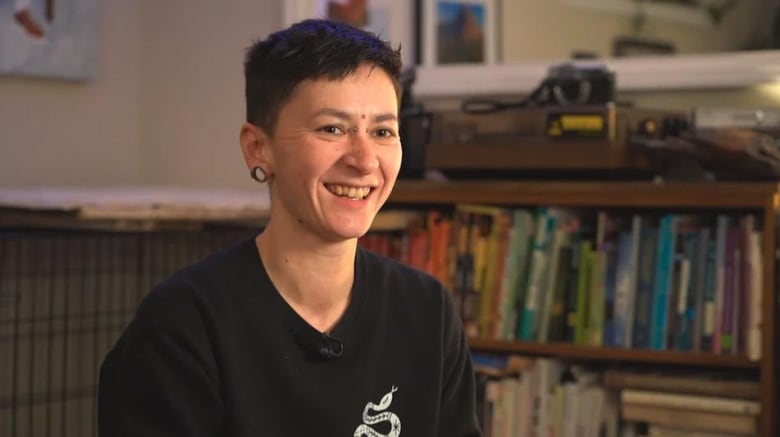Put down the phone, pick up the film: Old-school cameras making a comeback | CBC News

In an ever-increasing digital world where rarely an hour, let alone a day, goes by without gazing at a smartphone or tablet, some people are redeveloping their passion for a technology seemingly headed for extinction: the film camera.
In recent years, the popularity of the devices has outstripped supply — driven largely by a longing for an analog past.
The film photography industry was brought to its knees about a decade ago, but it’s experiencing a rebirth.
“I feel like I can attach more emotion to a film photo,” said Jasmine Orr, who owns about a dozen cameras and enjoys taking photos of urban landscapes in Edmonton.
Instead of pulling out a phone and snapping dozens of photos, a photographer using film has to be much more mindful and intentional because of the limits of a roll, Orr said.
“You have to focus on the moment a lot closer to take that photo,” they said. “Everything in the world is digital these days, and I needed something more concrete.”

Film has to be loaded into the camera and then removed in order to be developed. Some cameras operate without any batteries.
In 2006, Japanese camera maker Nikon announced it would stop manufacturing most of its film cameras to focus on digital. In 2012, Kodak filed for bankruptcy, although these days it can’t keep up with the explosion in demand for film cameras.
‘Nostalgia factor’ part of appeal of film cameras
McBain Camera never stopped selling the cameras and rolls of film since the Alberta shop opened its doors in 1949, but enthusiasm cratered from about 2007 to 2019.
Since then, sales have been up by double digits each year for film cameras, and the overwhelming majority of customers snatching up the analog devices are people under the age of 25.
“The big reason why people are getting back into film is because of the process and the nostalgia factor,” said Rene Rodrigue, general manager at McBain Camera in Edmonton.

“Much like people enjoy cooking from scratch because of the process of cooking from scratch. The same with film. They enjoy that process of slowing things down. They don’t have to have immediate results,” he said.
The shop processes 60 rolls of film a day, which isn’t enough to keep up with customer demand.
The rapid rise in popularity has caused prices to increase as manufacturers of cameras, film and other accessories weren’t prepared for the reversal of fortune.
“They are higher than they ever were before,” Rodrigue said, with cameras ranging in price from about $70 to $8,000 at the store.
Rolls of film have doubled in price to about $20 or $30, depending on the quality and the different colour tones they produce.
“It’s like talking about wine and coffee. You wind up with varietals and different display techniques,” Rodrigue said as points to shelves showing about a dozen different types of film canisters.
You can’t develop a roll of film at the grocery store these days, so a group of shutterbugs in St. John’s are building a community darkroom. They call their group, “Dark NL”.
Interest in film photography was increasing before the COVID-19 pandemic began three years ago, but the trend accelerated when people found they had much more time on their hands as sports, entertainment and shopping facilities were locked down.
“Same reason why people started baking bread or got into vinyl or things like that,” Rodrigue said. “People needed an outlet for what they were experiencing at the time.”
Store produces 10,000 rolls a week
For Dave Marshall, all of that extra time was why he decided to open a camera store, which has quickly evolved into a small factory that now ships film and other products around the world, including to Europe, Hong Kong and Australia. The latest box being packed is bound for Israel.
Flic Film is based in Longview, Alta., a village of about 300 people located in a ranching area with mountain views about 65 kilometres south of Calgary.
The shop sells about 200 different products, with about half of the items manufactured in-house. Besides producing 10,000 rolls of film a week, the business also mixes chemicals and sells kits to develop film at home.

“We were kind of stuck with COVID, so I got bored and started a company,” said Marshall, who has designed some machinery used at the shop. “I had problems with suppliers at the time supplying me photochemistry and some accessories. So I thought, well, I’m going to start blending some of my own chemistry.
“I’ve had three major companies approach us asking us if we would give them designs from our machines. And the answer has been each time, ‘We’d be happy to roll your film for you,'” he said.
The business is only a few years old, but it’s undergoing another expansion to boost its production capacity to keep pace with customer demand.
It’s another sign that the popularity of film continues to grow — although no one expects the industry to return to its heyday many decades ago because of the ease of smartphone photography and the quality of digital cameras.

For many photographers who shoot with film, they haven’t given up on their digital cameras altogether but instead see the two technologies as complementing each other.
“The quality with a digital camera is going to be sharper. You’re going to have a million pixels in an inch,” said Orr, the Edmonton photographer. “With a film photo, depending on the camera you use, it’ll be blurry no matter how good the lens is, and it’ll be grainy. But I love the character it has.”
Share this news on your Fb,Twitter and Whatsapp
Times News Express:Latest News Headlines
Times News Express||Health||New York||USA News||Technology||World News
